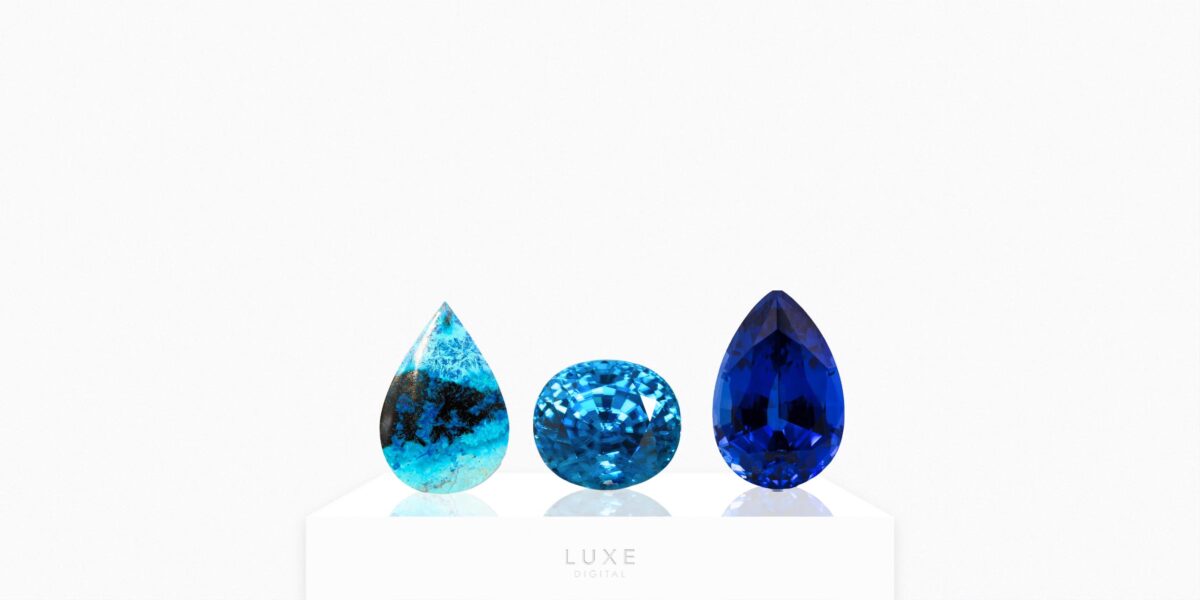From light blue to azure blue: the dazzling world of blue gemstones and crystals is more expansive than many realize. Blue gemstones are the centerpiece for some of the best jewelry brands. Whether worn alone for birthstone jewelry or even used for colorful engagement rings and cocktail rings, it’s hard to underestimate the value of blue gems today.
While some blue gemstones—like blue diamonds—are expensive and rare, others are quite accessible. Wisdom, creativity, hope, everlasting love and renewal are just a few symbolic meanings attached to these gorgeous blue gems and crystals.
If you think you know all of the most beloved blue gemstones, think again. This list will introduce you to blue gems, some familiar and some less so. And one thing is for sure: there’s at least one blue gem that’ll catch your eye—and make you rethink what you know about precious and semiprecious stones:
- Apatite
- Aquamarine
- Azurite
- Benitoite
- Blue Diamond
- Blue Fluorite
- Blue Jadeite
- Blue Marble
- Blue Moonstone
- Blue Opal
- Blue Pearls
- Blue Spinel
- Blue Tourmaline
- Blue Zircon
- Cavansite
- Chalcedony
- Dumortierite
- Grandidierite
- Halite
- Hawk’s Eye
- Hemimorphite
- Iolite
- Jeremejevite
- Kyanite
- Lapis Lazuli
- Larimar
- Lazulite
- Neon Apatite
- Paraiba Tourmaline
- Sapphire
- Scorodite
- Shattuckite
- Sillimanite
- Smithsonite
- Sodalite
- Spectrolite
- Tanzanite
- Topaz
- Turquoise
- Viviante
Apatite
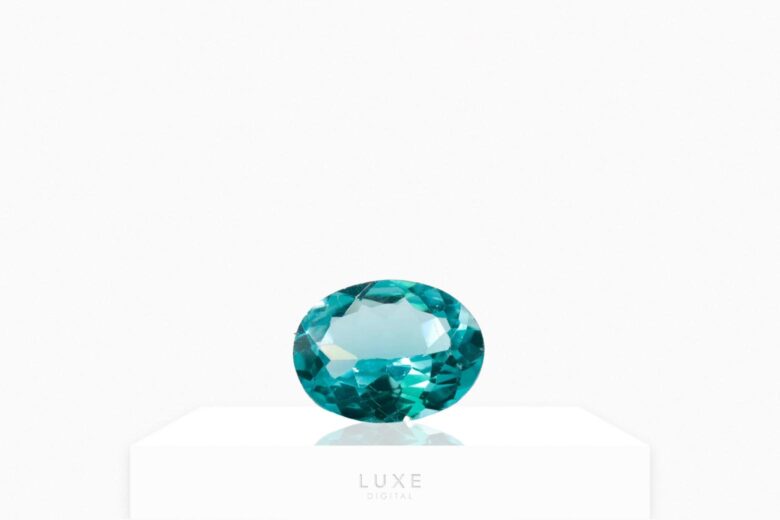
While pea green is its most well known color, apatite can also be light blue, teal, dark blue and myriad other colors. Noteworthy for its indistinct cleavage, vitreous luster and streaks of white, apatite is a phosphate mineral that forms in marine-based sedimentary rocks. Most apatite comes from Brazil, Myanmar, and Mexico.
Benefits and Use
Apatite is used to improve calcium absorption and in alternative medicine for supporting healthy joints and metabolism. It’s likewise heralded by collectors for its gorgeous hues.
Mohs Hardness Score: 5; suitable for collecting and crystal healing. Price: $
Aquamarine
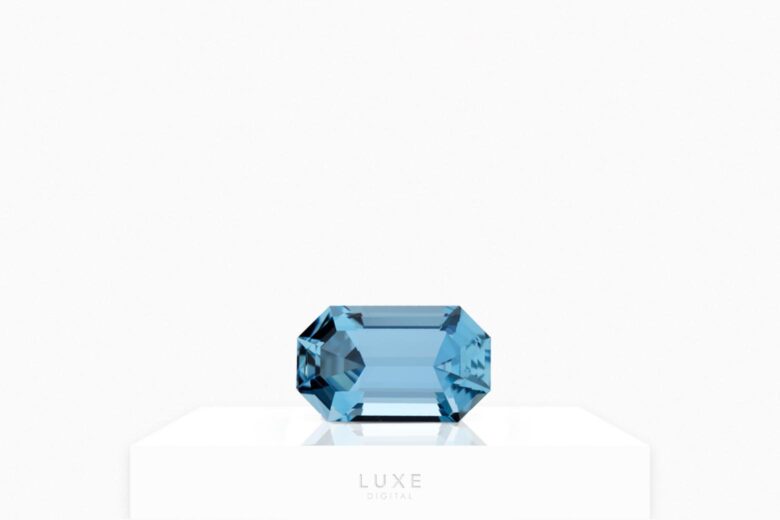
Aquamarine is one of the most well-known light blue gemstones. Best known as March’s birthstone, this enchanting semi-precious gem is a form of beryl. Its color ranges from pale blue to turquoise with pastel to intense hues. Sometimes heat-treated, aquamarine is both widely lab-grown and sourced naturally from Brazil, Nigeria, Madagascar, and Pakistan.
Benefits and Use
Aquamarine has been used as a talisman for sailors, a sign of true and eternal love, and even as a blue healing crystal. Of course, its most popular use is birthstone jewelry.
Mohs Hardness Score: 7.5 to 8; suitable for daily wear. Price: $$
Azurite
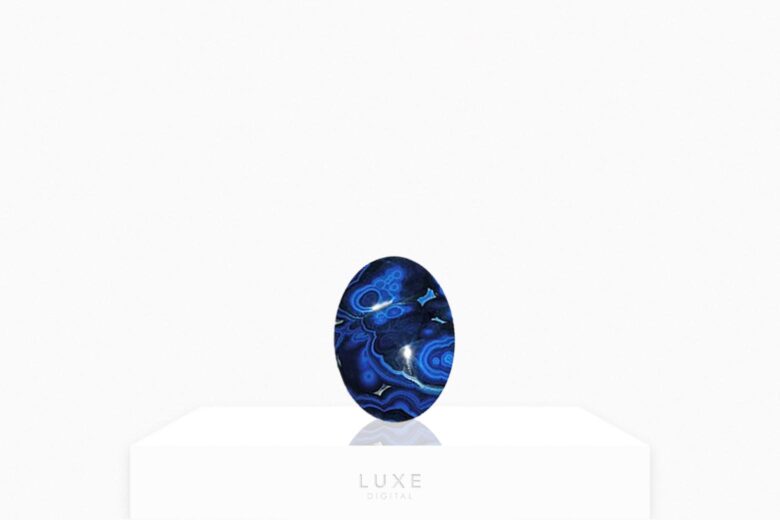
Azurite forms deep blue crystals and is the result of decaying copper deposits. This lesser known but gorgeous blue gem can appear light blue under certain conditions. Its vitreous luster and violet undertones bring to mind a majestic sky. Azurite primarily comes from France, with smaller deposits in Arizona, Morocco, and Namibia.
Benefits and Use
Azurite is used for removing obstacles—both physical and mental—and allowing you to realize your full potential. It’s most popular as a decorative gemstone, and sometimes faceted into beads.
Mohs Hardness Score: 3.5 to 4; suitable for decoration Price: $ to $$$
Benitoite
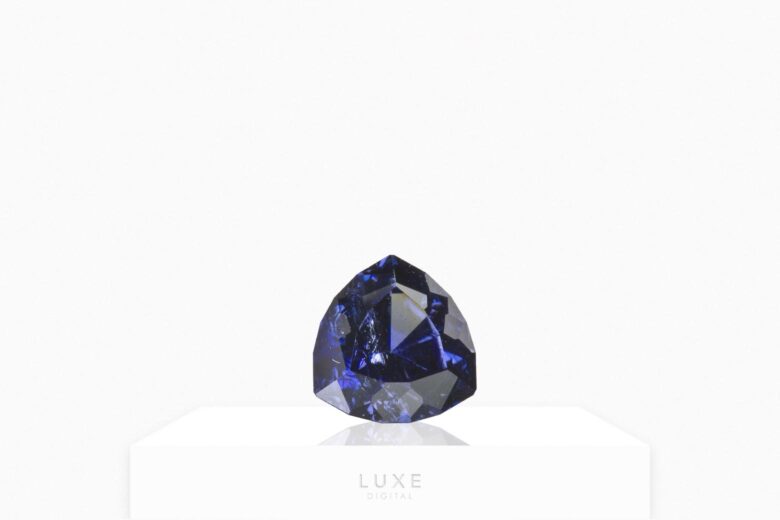
If you’ve never heard of benitoite, you’re not alone. It’s a quite rare form of barium titanium cyclosilicate—and just so happens to be one of the most valuable gemstones. From bright blue to blue with whire undertones, benitoite exhibits brilliant blue fluorescence under sunlight. Carrying a price per carat between $6,000 to $10,000, this gorgeous blue gemstone can only be found in a small county in California.
Benefits and Use
Benitoite is a healing gemstone, and many use it to enhance communication and both physical and psychic energy.
Mohs Hardness Score: 6 to 6.5; suitable for collecting and crystal healing. Price: $$$
Blue Diamonds
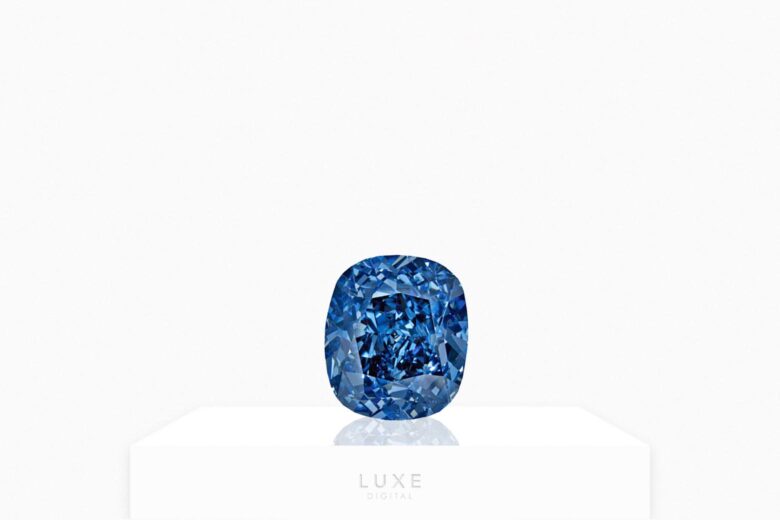
Colorless diamonds are the preferred precious stone for engagement rings. Yet it’s some blue diamonds that are among the most expensive diamonds in the world. Blue diamonds are exceptionally rare and come from a handful of mines in the world: one in South Africa, one in Australia, and one in India. Though blue diamonds share the same primary physical properties as other diamonds, their color comes from boron atoms.
Benefits and Use
Blue diamonds are prized by collectors and fashioned into luxury jewelry—mainly rings. Blue diamonds symbolize devotion and eternity, and are said to heal digestive ailments.
Mohs Hardness Score: 10; suitable for collecting, daily wear, luxury jewelry. Price: $$$
Blue Fluorite
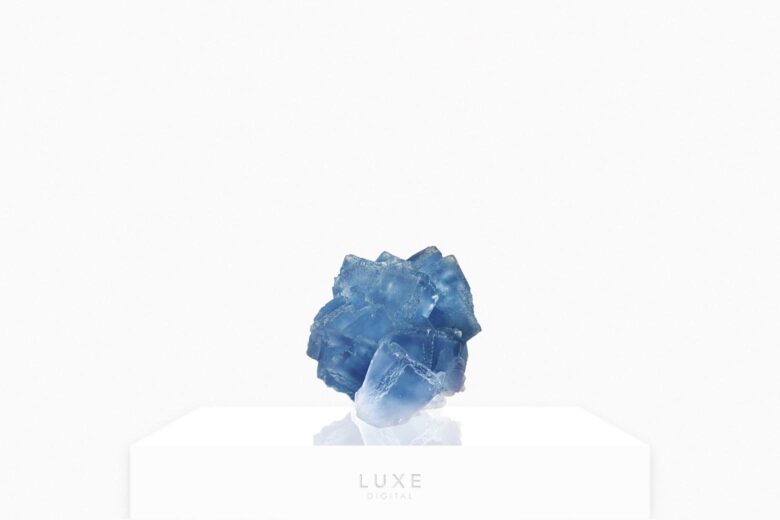
Blue Fluorite forms in both light blue and dark blue crystals in Illinois, regions of Mexico and China, and the Ardennes of Chile. A form of calcium fluoride, it gets its distinct colors from a combination of radiation and chemical impurities. Blue fluorite is often found in deep wall rock veins.
Benefits and Use
Both light blue crystals and dark blue crystals are thought to enhance mental clarity, reduce anger, and ease anxiety. Blue Fluorite aligns with the Third Chakra for spiritual growth.
Mohs Hardness Score: 4; suitable for decoration and meditation. Price: $
Blue Jadeite
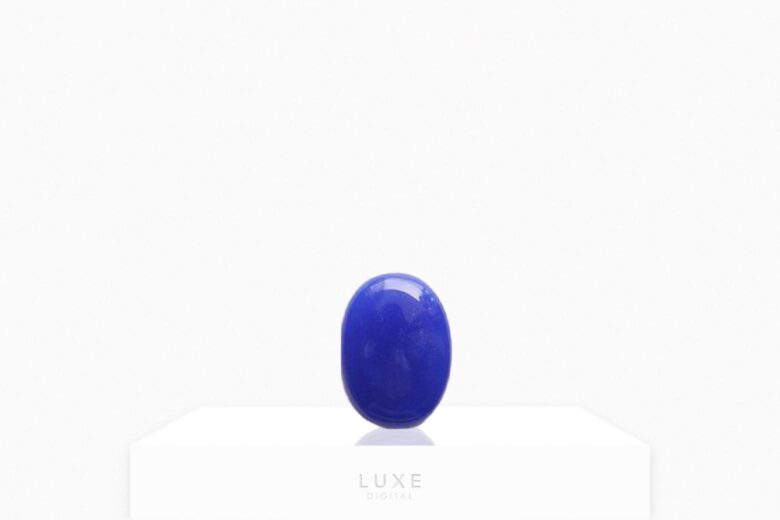
Blue is the rarest type of jadeite and is a beautiful greenish-blue to aqua to teal gemstone. From transparent to opaque, blue jade has fine fibrous flecks of white and smooth to the touch. Some of the finest blue jade forms in Northeastern Guatemala and is among the most expensive blue gemstones in the world.
Benefits and Use
Blue jadeite is used to reduce inflammation and calm the body. It’s also thought to detoxify the kidney, spleen and other organs. In some cultures—especially Asian—it’s heralded as a spiritual stone and used for sacred ornaments.
Mohs Hardness Score: 6.5 to 7; suitable for careful wear, decorative ornaments. Price: $$$
Blue Marble
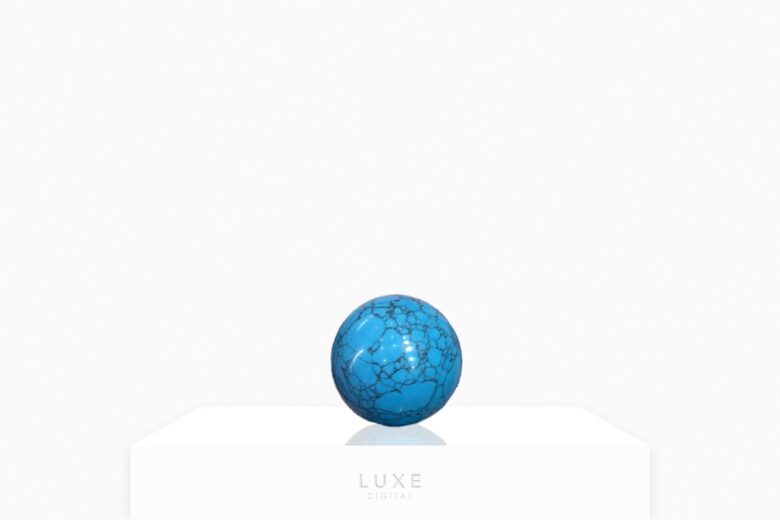
Marble is seemingly everywhere—from statues to kitchen counters to some of the men’s best luxury watches. Yet blue marble is an underappreciated gem, with heavy veins of dark blue and gray. The blue color comes from lazulite and oxides and has a sugar-like texture. Blue marble—and all variations of marble—is sourced worldwide, though half of it comes from China, Spain, Italy and India.
Benefits and Use
Monuments and kitchen counters are the most common uses for blue marble. Blue marble is also used to enhance intuition and awareness.
Mohs Hardness Score: 3; suitable for watch interfaces, construction. Price: $
Blue Moonstone
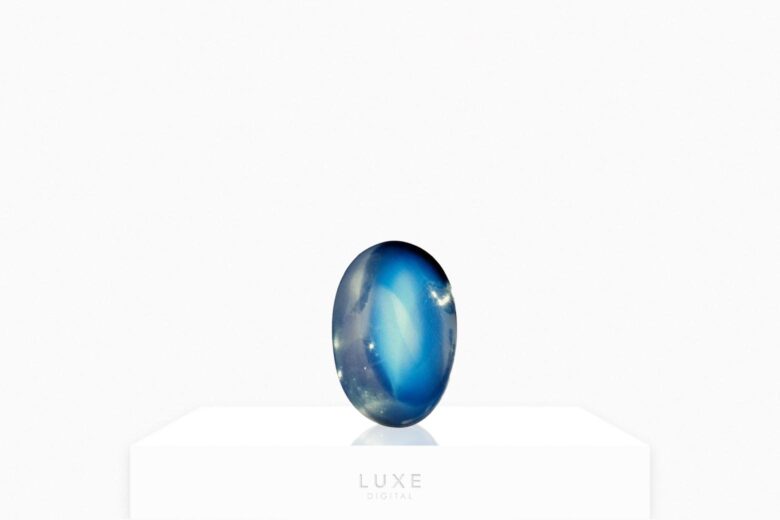
Moonstone is June’s mesmerizing and celestial gemstone—and blue moonstone is especially enchanting. A blue body color is complemented with flickering blue, silver or white adularescence. It forms as a result of magma cooling and can be found in Sri Lanka, India, parts of the United States, Myanmar, and Madagascar.
Benefits and Use
Blue moonstone promotes emotional balance, spirituality, and connection to moon cycles. It may be meditated with, worn as an amulet, or worn as gemstone jewelry.
Mohs Hardness Score: 6 to 6.5; suitable for occasional wear, meditative crystals/ stones. Price: $
Blue Opal
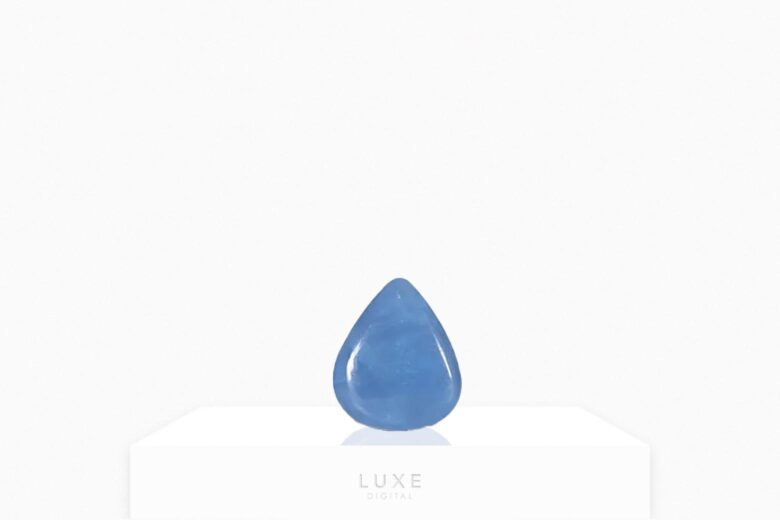
Opal is one of October’s birthstones and is a form of silica. Nicknamed the Queen of Gems, blue opal shows a play of color with light and deeper swirls. In sunlight, blue opal sometimes displays rainbow scintillation. Peruvian opal is bluish-green due to its copper inclusions. Other forms of blue opal are sourced from Oregon, Idaho and Nevada.
Benefits and Use
Blue opal not only can be fashioned into unique jewelry, but it’s also used for healing. Blue opal brings emotional balance and peace to the wearer.
Mohs Hardness Score: 5.5 to 6.5; suitable for careful wear, collecting. Price: $$
Blue Pearls
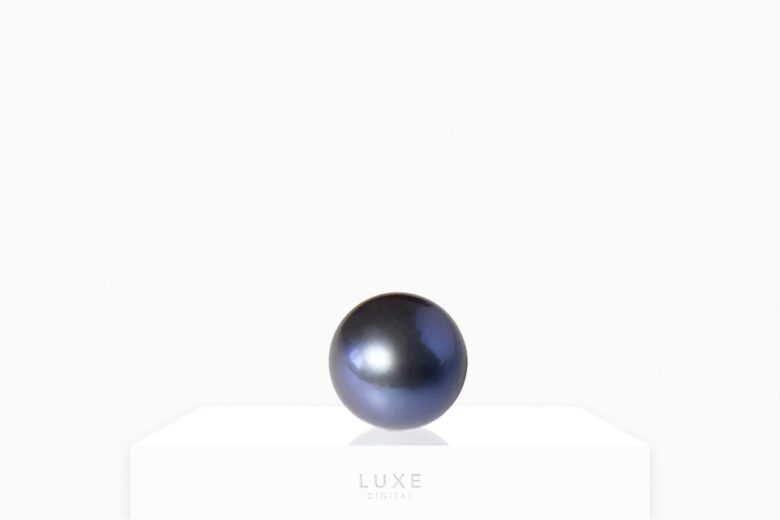
While pearls are best known for their ivory and white hues, blue pearls are a refined and sought-after elegant gem as well. Blue pearls include Tahitian, Freshwater, Akoya and South Sea pearls—they’re just much rarer than other colors. From grayish blue to dark blue to vivid blue, the highest quality blue pearls are rounded and exhibit beautiful luster. Like other pearls, blue pearls come from marine oysters and freshwater mussels.
Benefits and Use
Blue pearls are fashioned into beaded necklaces, bracelets, earrings, and, less commonly, cocktail rings. As symbols of truth, courage and peace, blue pearls heal physical ailments and bring forth one’s inner wisdom.
Mohs Hardness Score: 2.5 to 4.5; suitable for beaded bracelets but only with gentle wear. Price: $$ to $$$
Blue Spinel
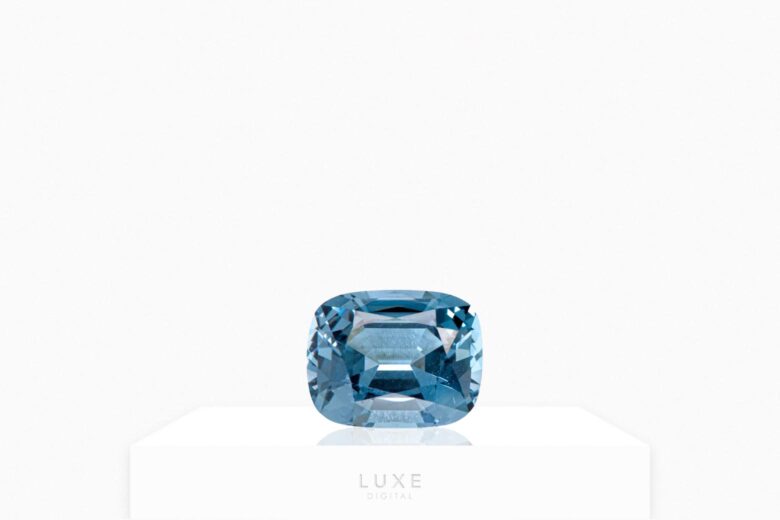
Just as red spinel has been mistaken for a ruby, blue spinel is often compared with sapphires. While blue spinel is nearly as vivid as a sapphire, its saturation is more muted. Cobalt blue spinel comes from Sri Lanka and owes its deeper blue hue to a higher concentration of iron. With octahedron crystals and a vitreous luster, blue spinel is appealing in both raw and polished forms.
Benefits and Use
Blue spinel is fashioned into cocktail and fine gemstone jewelry—often as a replacement for sapphires. Its benefits include inspiring passion and good health.
Mohs Hardness Score: 8; suitable for earrings, rings and necklaces. Price: $$
Blue Tourmaline
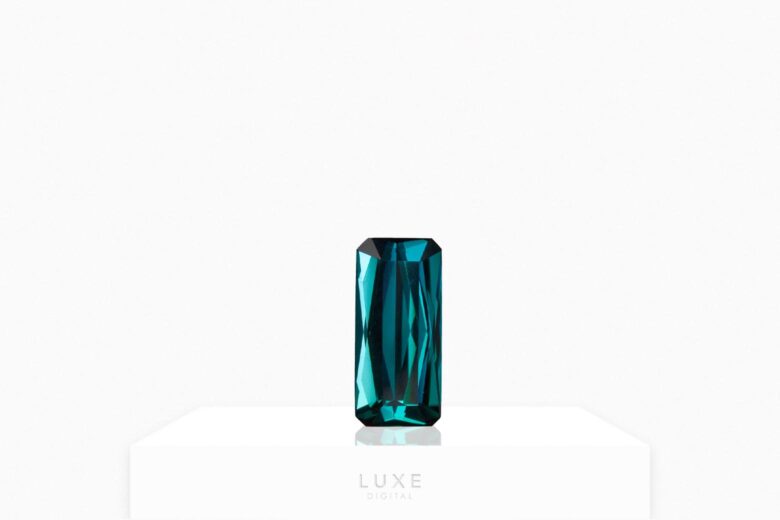
Tourmaline is rightfully nicknamed the rainbow stone, because it comes in a wide array of colors— including blue. Blue tourmaline is one of October’s birthstones and presents with an intense, neon blue. While tourmaline can be found around the world, the best electric blue and turquoise tourmaline comes from Brazil. Blue tourmaline is a type of boron silicate and forms in both igneous and metamorphic rocks.
Benefits and Use
Stunning cocktail jewelry and birthstone jewelry; blue tourmaline is also a receptive stone, used to bring serenity and wisdom.
Mohs Hardness Score: 7 to 7.5; suitable for birthstone jewelry. Price: $$
Blue Zircon
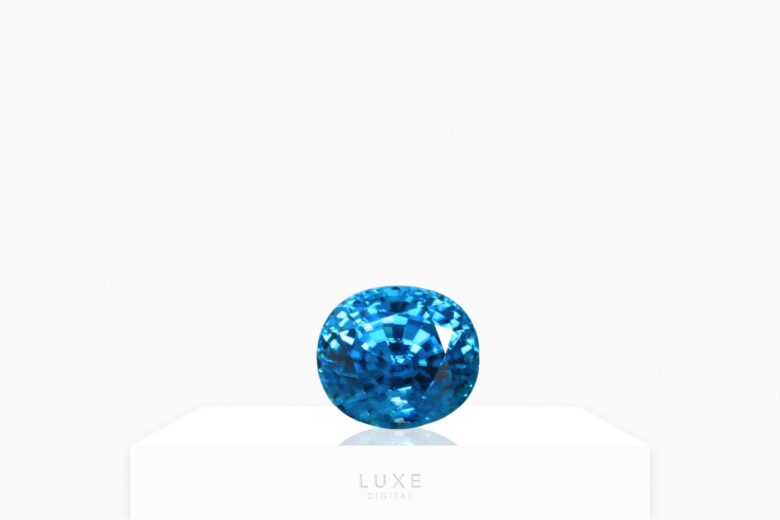
Zircon comes in a dazzling array of colors, but light to medium sky blue is one of the most enchanting. Blue zircon is a semi-precious gemstone that forms in heavy mineral sand deposits, mostly in South East Asia. When faceted, blue zircon displays beautiful fire and flashes of color. However, almost all blue zircon is heat-treated to enhance its natural beauty.
Benefits and Use
Blue zircon is a gem of reinvigoration and energization. Its beauty makes it sought-after for unique pendant necklaces and earrings.
Mohs Hardness Score: 7.5; suitable for daily wear. Price: $$
Cavansite
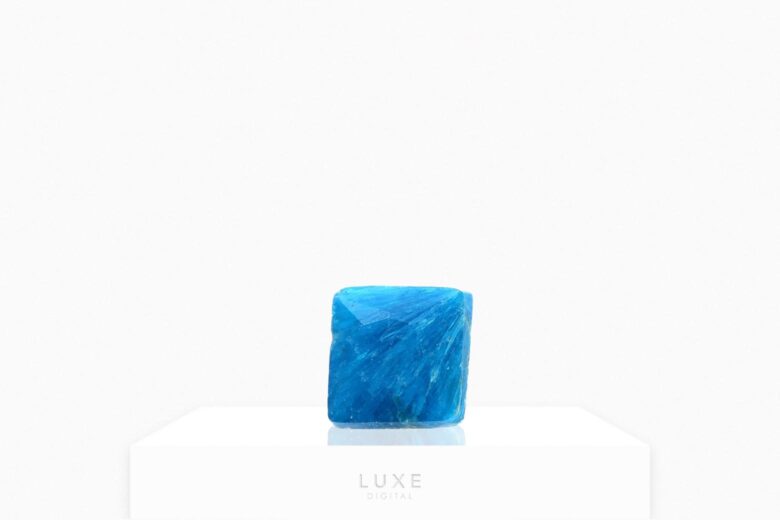
From deep saturated blue to turquoise, cavansite is a unique and expressive blue gemstone. It forms in orthorhombic crystals with a striking vitreous and transparent appearance. But it’s the pleochroism (color variation due to light interference) that makes this form of calcium phyllosilicate so unusual. This somewhat rare blue gem is sourced from India.
Benefits and Use
Cavansite is a spiritual stone, with the ability to connect and activate the 3 highest chakras. More so, cavanasite enhances communication between realms and makes one more aware of their spirituality.
Mohs Hardness Score: 3 to 4; suitable for decoration. Price: $$
Chalcedony
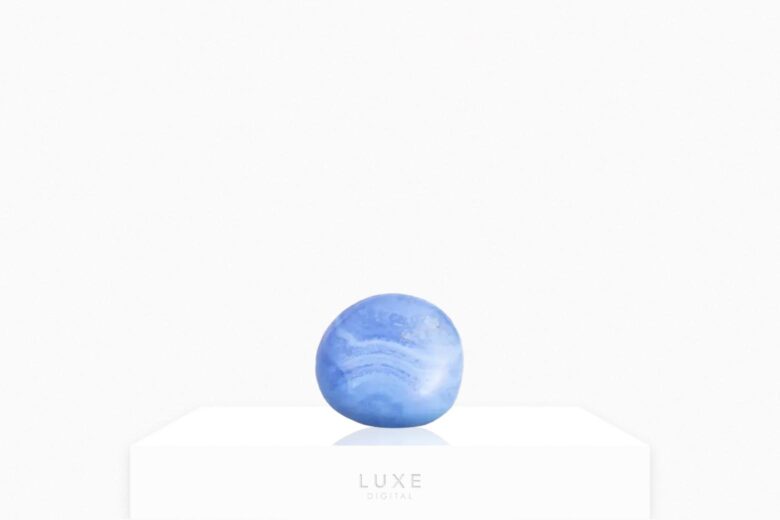
Chalcedony is a type of silica, with deposits of both moganite and quartz. With a waxy luster and grayish-blue appearance (other colors include brown and black), chalcedony is mostly smooth with tiny bubbles. Arizona, New Mexico and Mexico are the best sources of blue chalcedony.
Benefits and Use
Chalcedony brings out self confidence and instills peace. This blue gem is collected by anxiety and longing for peace.
Mohs Hardness Score: 7; suitable for collecting and crystal pendants. Price: $ to $$
Dumortierite
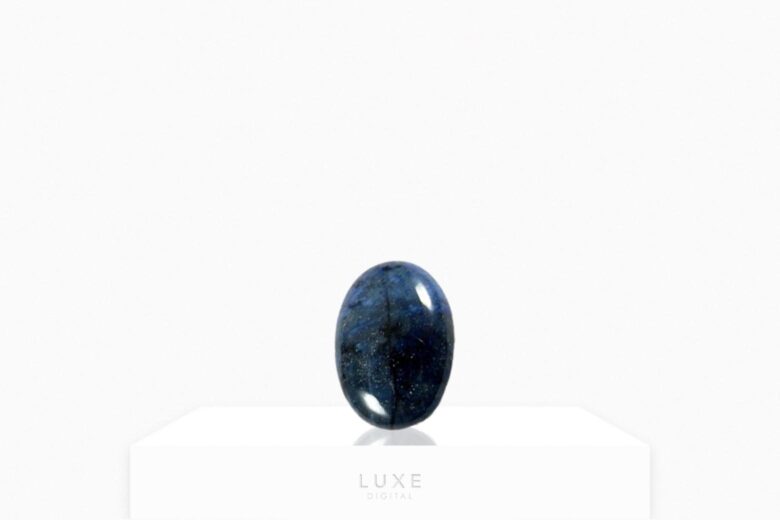
Dumortierite is yet another rare blue gem that few know. Composed of aluminum and iron, dumortierite forms fibrous crystals in Austria, Brazil, Canada, France, Italy, Sri Lanka and a handful of other countries. It’s an unusual form of quartz, with a dark blue to navy blue, speckled appearance. It’s often confused with sodalite and sometimes used as a cheaper alternative to lapis lazuli.
Benefits and Use
Dumortierite has calming energy and brings both peace and harmony. Called a charm of light, it’s most popular as beads for both meditation and collecting.
Mohs Hardness Score: 7; suitable for collecting. Price: $
Grandidierite
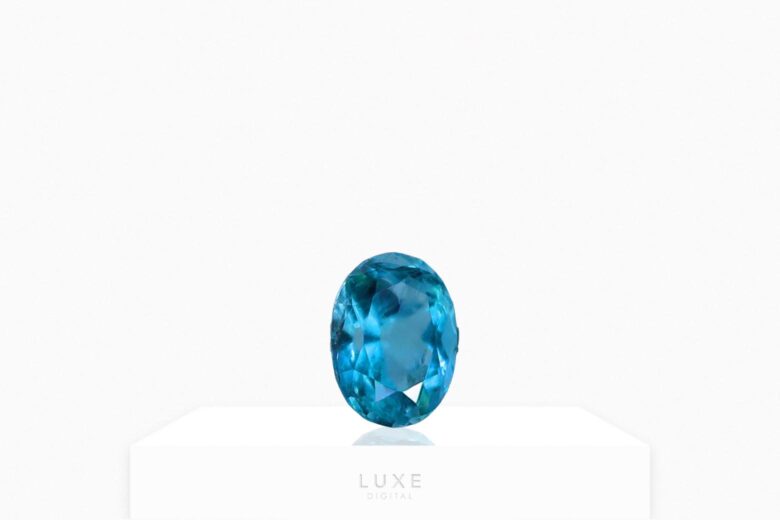
Grandidierite was named for the French explorer Alfred Grandidierite. This sea-green to turquoise gemstone gets its blue undertones from iron deposits. Yet its ability to showcase three different colors at once (pleochroism) makes this gem so fascinating. It has a vitreous to glassy luster. Madagascar, New Zealand, Norway, Canada and even Antarctica are a few places it’s found—yet it’s considered rare.
Benefits and Use
Grandidierite inspires the user to take positive steps forward and envision the future. It’s sold as beaded necklaces and bracelets as well as dangle earrings.
Mohs Hardness Score: 7.5; suitable for jewelry but too brittle for daily wear. Price: $$ to $$$
Halite
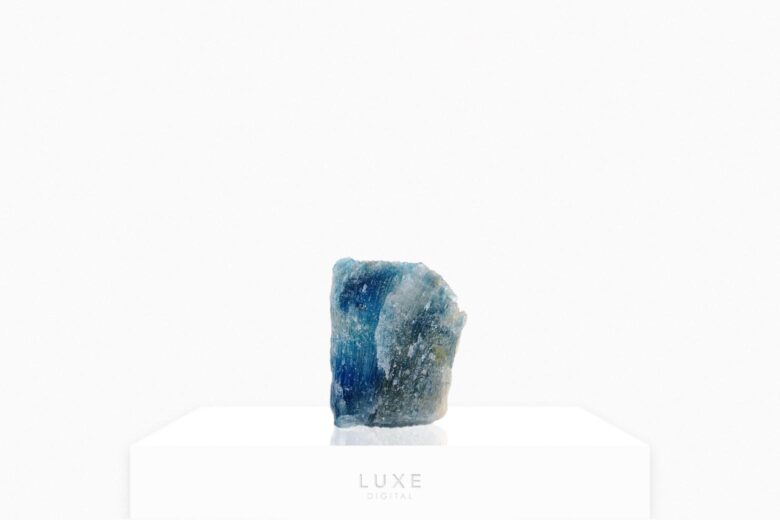
The name halite may not be familiar with everyone, but its use is. White halite is the same thing as table salt. But halite also forms pink and blue crystals. Blue halite thus is a rare form of sodium chloride. It has notable impurities, a grainy surface, and inconsistent light blue, dark blue and white patterns. Both blue and purple halite crystals are sourced from Northern Germany and most of North America.
Benefits and Use
Halite is aligned with the third chakra and used to remove energy blockages. It cleanses and lifts emotions.
Mohs Hardness Score: 2 to 2.5; suitable; table salt. Price: $
Hawk’s Eye
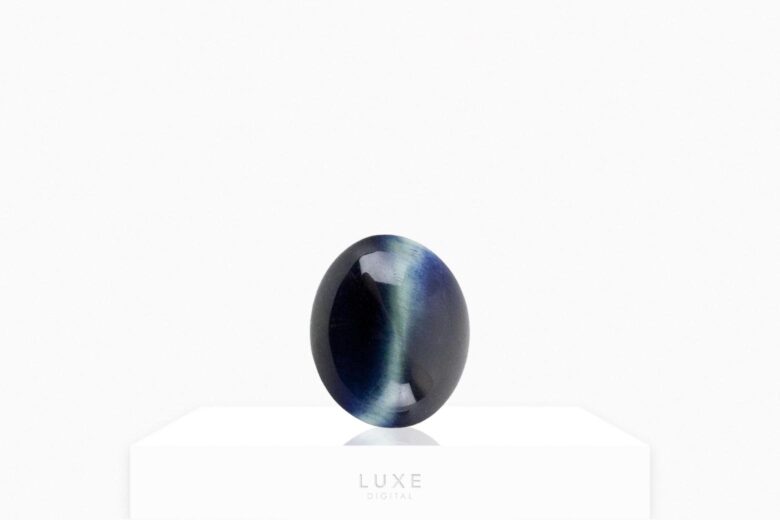
You may know Hawk’s Eye by one of its two other names: Blue Tiger’s Eye or Falcon’s Eye. It gets its nickname (Falcon’s Eye) from its banded dark blue and gray-blue appearance. But it’s simply another form of Tiger’s Eye, one of the best yellow gemstones. Like all Tiger’s Eye, Hawk’s Eye exhibits chatoyancy, a cat-eye color effect. Hawk’s Eye is found in Burma, China, South Africa, and Australia.
Benefits and Use
Hawk’s Eye connects the wearer to their inner mind by lifting the subconscious. This dark blue gem is aligned with the Third Chakra.
Mohs Hardness Score: 6.5 to 7; suitable for casual wear, beaded bracelets. Price: $
Hemimorphite
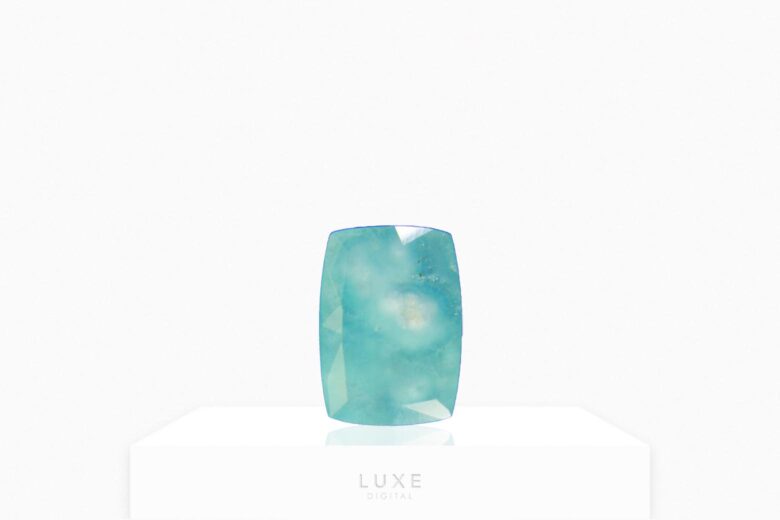
Hemimorphite is a form of silicate, typically extracted from both lead ore and mine ore. While it can also be white or colorless, its light blue crystals are the most notable, paired with a silky luster. Hemimorphite polished gems are faintly speckled and have an uneven fracture. They’re found in the United States, Siberia, Romania, and Belgium.
Benefits and Use
Hemimorphite promotes spiritual growth and heals headaches. Some use it to achieve weight loss and heal emotional pain.
Mohs Hardness Score: 4.5 to 5; suitable for collecting. Price: $
Iolite
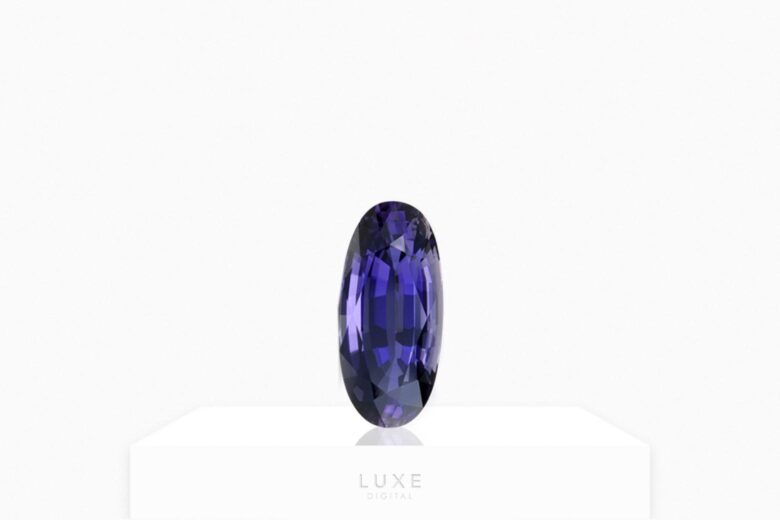
Iolite is a gorgeous violet to deep blue gemstone. While it’s a type of cordierite, its spiritual benefits are often compared with Amethyst. Depending on the sun’s light or time of day, this gemstone shifts to deeper purple or deeper blue. It’s pleochroic, meaning you have to see multiple hues depending on the angle. Certain inclusions create a Cat’s Eye effect. It’s found in alluvial deposits within Sri Lanka, Kenya and Tanzania.
Benefits and Use
Iolite is the official gemstone for celebrating a 25th anniversary. It also provides clarity, intuition and acceptance.
Mohs Hardness Score: 7 to 7.5; suitable for anniversaries, special occasions. Price: $ to $$
Jeremejevite
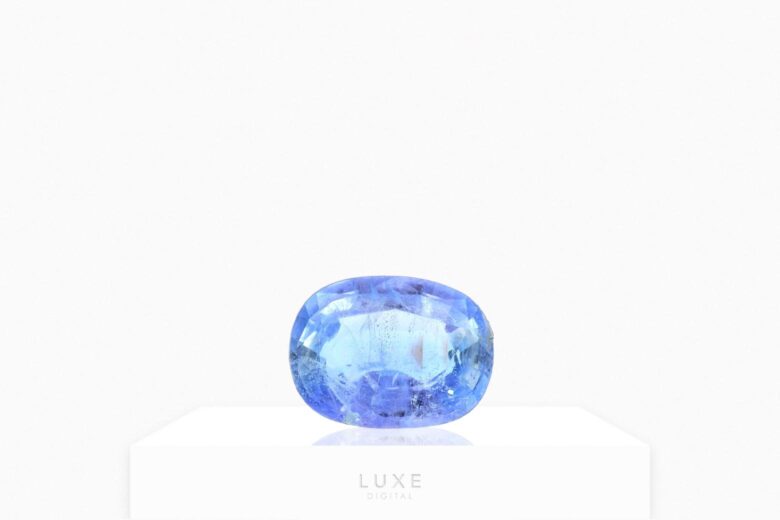
Jeremejevite is an aluminum borate mineral that’s found alongside quartz, topaz and garnet. While it can also be yellow, it’s known for its light, cornflower blue appearance. Jeremejevite is both transparent and vitreous, with feather-like inclusions. It comes from Myanmar, Germany, Madagascar, and Russia.
Benefits and Use
Jeremejevite is used during meditation to instill intuition and a deeper connection with oneself.
Mohs Hardness Score: 6.5 to 7.5; suitable for meditation. Price: $ to $$
Kyanite
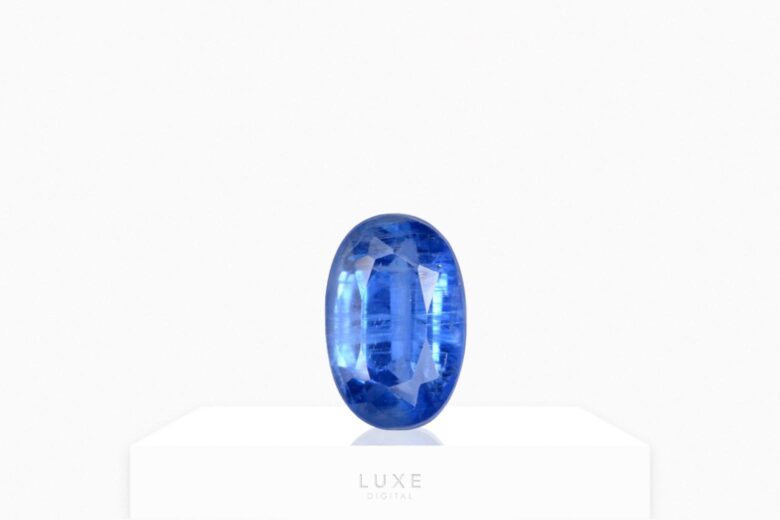
Kyanite is a form of silicate that forms in clay deposits. Its elongated crystals feature patchy light to deep blue colors, accompanied by streaks of white and gray. Kyanite is fibrous and banded with the ability to show multiple colors from different angles. It comes from Myanmar, Cambodia, Kenya, Napal, Brazil, Switzerland and within the United States.
Benefits and Use
Kyanite crystals balance emotions, calm the mind, and bring peace. But Kyanite also is used in construction, for molds, and furnaces.
Mohs Hardness Score: 4.5 to 7; suitable for meditation, construction uses. Price: $
Lapis Lazuli
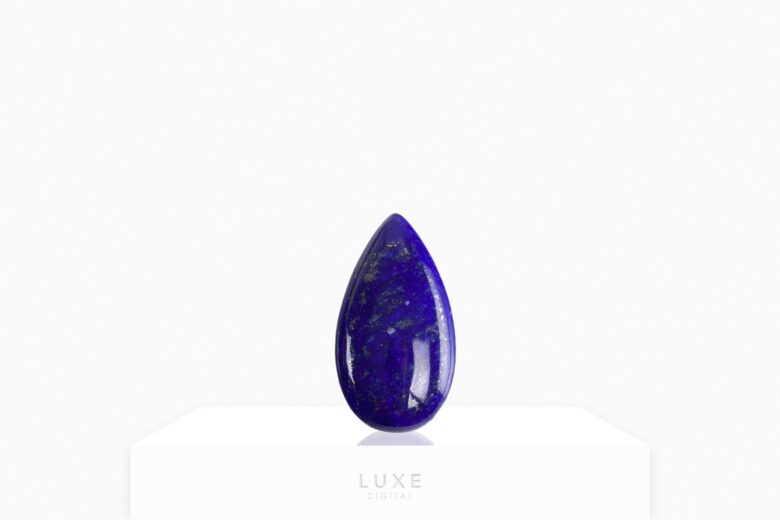
Lapis Lazuli is known for its vivid blue hue with green and purple undertones. This mystical semi-precious gemstone is a form of sodalite and exhibits vein-like patterns due to calcite deposits. Its color is multidimensional, ranging from indigo to cobalt to royal blue. The finest lapis lazuli comes from Chile, Russia and Persia.
Benefits and Use
Lapis lazuli promotes emotional healing, well-being, and wisdom. Its beauty makes it a sought-after choice for a wide range of jewelry.
Mohs Hardness Score: 5 to 6; suitable for cocktail accessories. Price: $ to $$
Larimar
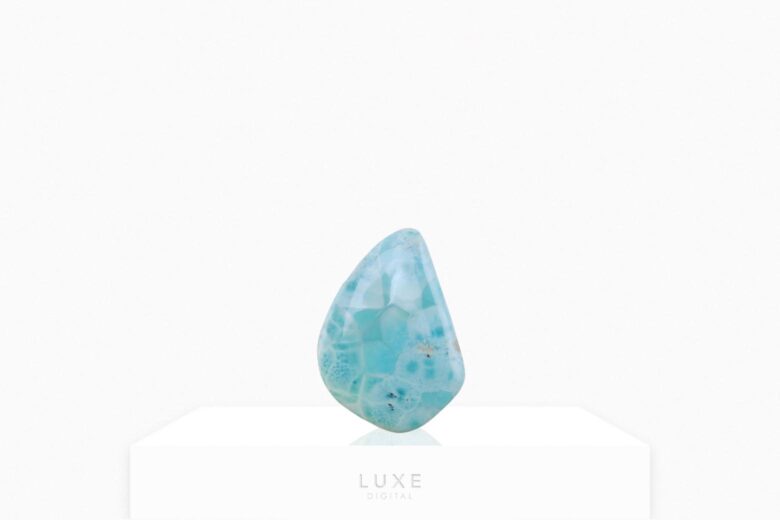
Larimar is a light aqua blue gemstone that can only be found in the Dominican Republic. It’s a type of pectolite (a silicate mineral) that forms bluish-white, teal, turquoise and even dark blue crystals. The most exceptional larimar impresses with vibrant blues, balanced with patches of soft white. Copper deposits influence the blue hues.
Benefits and Use
Larimar heals everything from physical to emotional to spiritual ailments. It’s associated with the Third Chakra and enlightens the soul.
Mohs Hardness Score: 4 to 7; suitable for meditation, beaded necklaces. Price: $ to $$
Lazulite
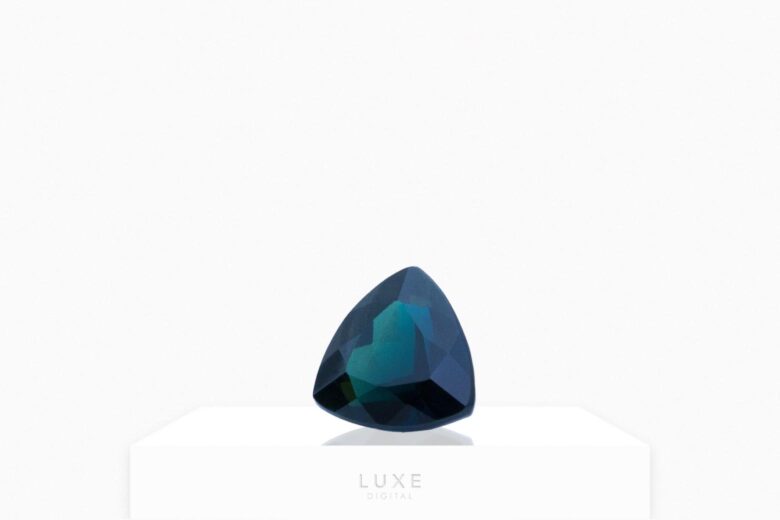
Lazulite is a phosphate mineral that comprises magnesium, iron and aluminum. Its wedge-shaped crystals range from gray blue to dark blue, with indigo being the most popular color. Distinguished by a vitreous luster and white streaks, lazulite is found in Austrria, Sweden, Brazil, and California.
Benefits and Use
Lazulite, like many blue crystals, is aligned with the Third Chakra. Because of this, lazulite is used to connect with the subconscious and heal the mind.
Mohs Hardness Score: 5.5 to 6; suitable for healing. Price: $ to $$
Neon Apatite
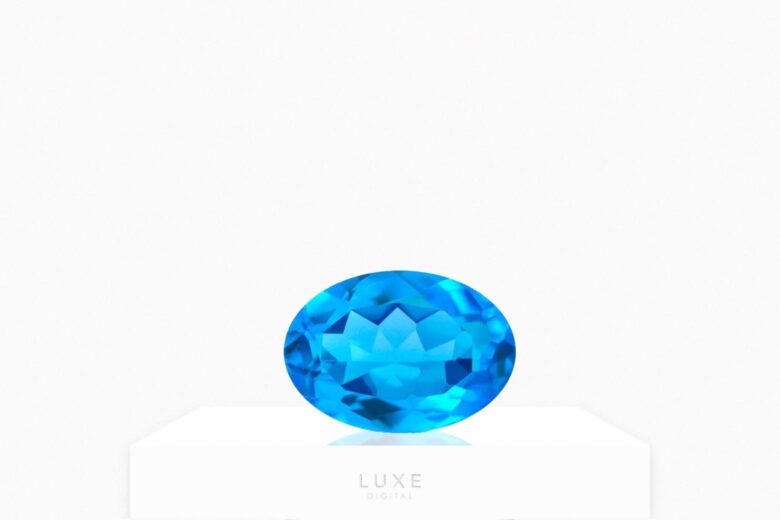
Neon apatite is one of the most stunning but also rare blue gemstones. Sourced only from the Brazilian state of Goias, neon apatite is known for its electric blue color. From light neon blue to dark neon blue, this gemstone is vivid and transparent but also brittle. Its vitreous luster is equally appealing, yet it has poor wearability.
Benefits and Use
Neon apatite is used to envision possibilities. It promotes growth and development and is used for meditation.
Mohs Hardness Score: 5; best for collecting, though used for fine jewelry. Price: $ to $$
Paraiba Tourmaline
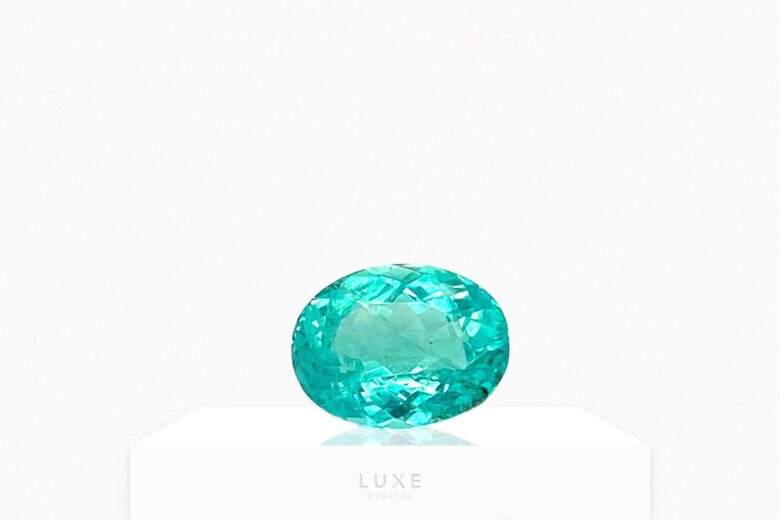
Paraiba tourmaline is a type of tourmaline distinguished by its copper deposits. It’s those deposits that give it an expressive sea blue, aqua, or bluish-violet color. It can be opaque or transparent, complemented with a hexagonal crystal formation. Found in small quantities in Brazil, it’s a rare and exceptional form of tourmaline.
Benefits and Use
Paraiba tourmaline promotes relaxation and healthy blood flow. It’s used to enlighten and reflect on one’s life.
Mohs Hardness Score: 7 to 7.5; suitable for collecting or fine jewelry. Price: $$$
Sapphire
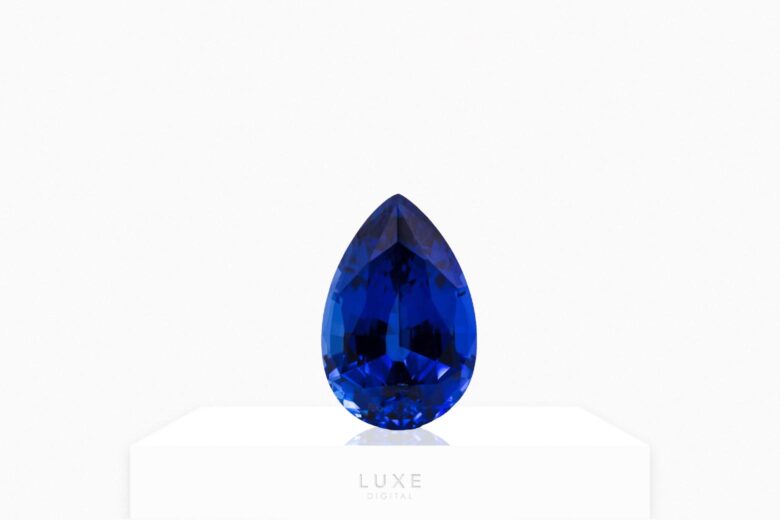
Sapphire is a precious gemstone, September’s birthstone, and one of the most sought-after blue gemstones today. This gorgeous gemstone is in the corundum mineral class and exhibits colors ranging from light blue to violet blue to royal blue. It reflects light beautifully and may appear different shades of blue depending on the time of day. Sapphires come from Myanmar, Australia, Thailand, and other regions.
Benefits and Use
Sapphires are used for fine gemstone jewelry, for collecting, and prized for their association with royalty, truth and wisdom.
Mohs Hardness Score: 9; diamond ring alternative, fine jewelry. Price: $$ to $$$
Scorodite

Scorodite is a hydrated form of iron arsenate, with promising industry purposes. It ranges from greenish blue to grayish blue or liver brown with earthy undertones. Scorodite crystals form in octahedrons and may be inconsistent in their coloration. The most appealing scordorite are light blue and found in the Saxony District of Germany.
Benefits and Use
Scordorite is mostly used as an arsenic stabilizer. It’s also believed to promote deep thought and connect the heart and throat chakras.
Mohs Hardness Score: 3.5 to 4; suitable as a stabilizer. Price: $$ to $$$
Shattuckite
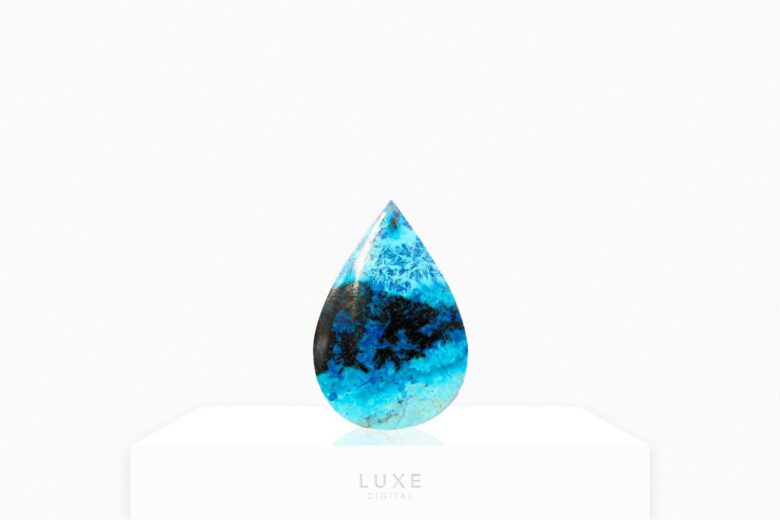
Shattuckite is a copper silicate mineral that forms fibrous, needle-shaped crystals. Its crystals are pale blue, medium blue or deep blue, all with green undertones. It’s known most for a light cerulean blue body with deep blue banding. It primarily comes from an Arizona-based mine.
Benefits and Use
Shattuckite is used primarily for intriguing crystal healing. Many believe shattuckite’s powerful properties repairs DNA and heals damage from radiation.
Mohs Hardness Score: 3.5; suitable for collecting and meditation. Price: $ to $$
Sillimanite
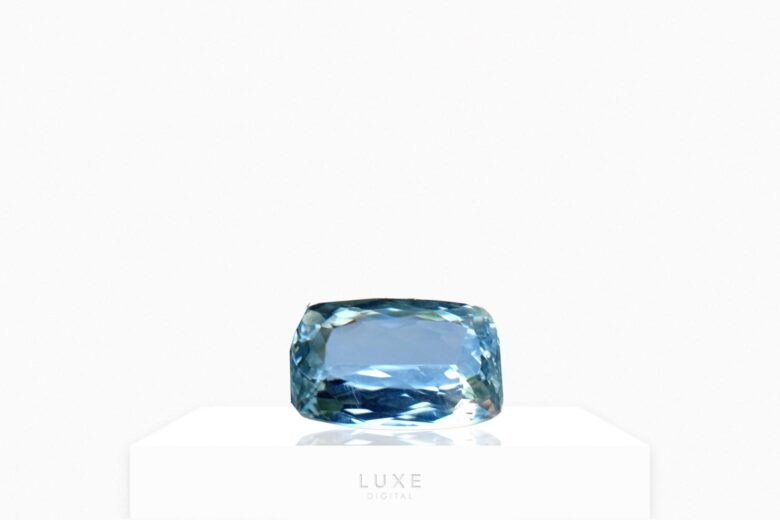
Sillimanite is interchangeably called fibrolite. This glassy mineral forms fibrous, needle-like crystals in clay-based rocks. While some forms of sillimanite are faint green or brown, sillimanite is more loved for its vivid deep blue. Sillimanite comes from a single region in Delaware and thus is not widely available.
Benefits and Use
Sillimanite may not be used widely in the jewelry industry, but it is prized for its healing properties. This dark blue gem is thought to aid digestion and clear both the sinus passages and lungs.
Mohs Hardness Score: 7; suitable for collecting and crystal healing, casual bracelets. Price: $
Smithsonite
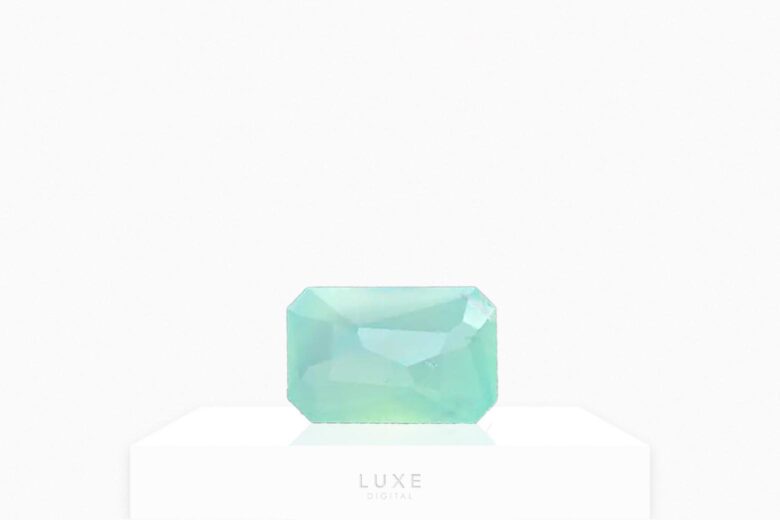
Smithsonite is a type of zinc carbonate that was once mistaken for hemimorphite. Its heavier deposits of iron distinguish itself from other forms of calcite, along with its unique blue-green crystals. While smithsonite can also be brown, gray, or white, the light blue color is a great choice for collectors. Blue-green smithsonite comes from New Mexico.
Benefits and Use
Smithsonite aids the reproductive system and promotes endocrine balance. It’s also used to improve energy levels and physical stamina.
Mohs Hardness Score: 4.5; suitable for collecting. Price: $
Sodalite
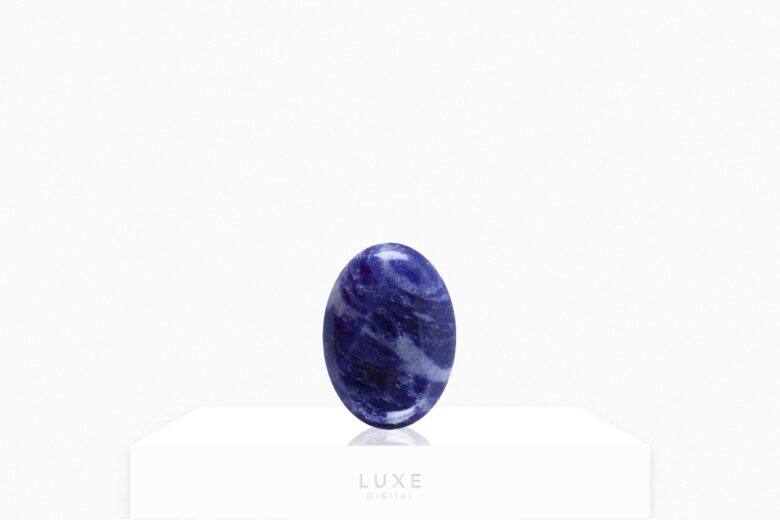
Sodalite has been called the gemstone of cosmic beauty, and rightfully so. Its distinct deep blue to purplish blue body features vein-like inclusions of white. The highest quality sodalite is royal blue with a waxy luster. Sodalite is sourced from the veins of igneous rocks in Ontario and Quebec.
Benefits and Use
Like many blue crystals and gems, sodalite heals and brings balance. It’s a calming and soothing gem and can also be fashioned into casual rings.
Mohs Hardness Score: 5.5 to 6; suitable for collecting and crystal healing. Price: $
Spectrolite
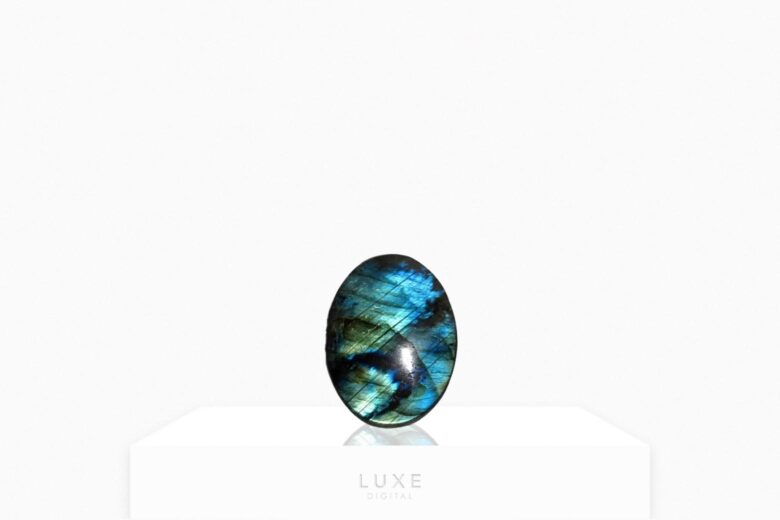
Spectrolite is a rare form of labradorite. What’s unique about this blue gemstone is its exquisite display of iridescent colors. It ranges from grayish blue to blue green with gray undertones, but those colors are multidimensional. While spectrolite is found in Canada and Madagascar, the finest quality spectrolite is sourced from Finland.
Benefits and Use
Spectrolite is a stone of courage. It clarifies the mind, provides focus, and encourages taking a leap of faith.
Mohs Hardness Score: 6 to 6.5; suitable for collecting. Price: $
Tanzanite
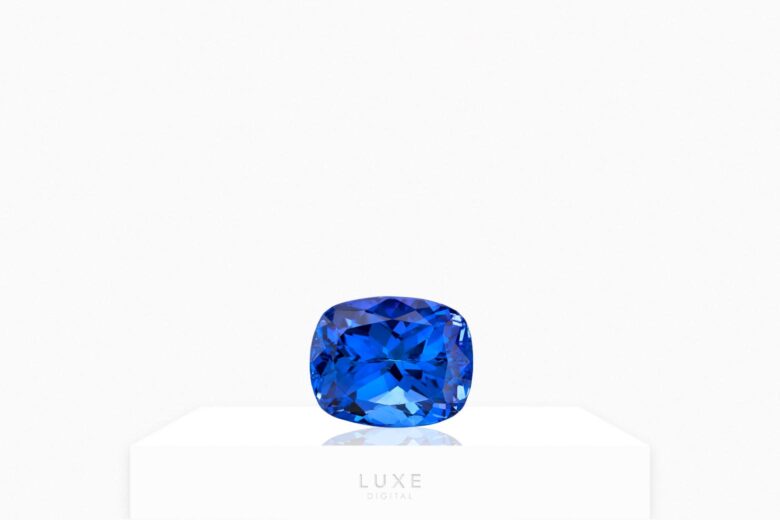
Tanzanite is most known for being one of December’s birthstones. This mystical gem ranges from dark blue to violet, but it’s a saturated violet blue that’s most prized. That beauty is exemplified by tanzanite’s pleochroism (the ability to showcase multiple colors) as light passes through. Tanzanite comes from a small region in Northern Tanzania, making it a rare blue gemstone.
Benefits and Use
Tanzanite is used for fine jewelry—from beautiful rings to necklaces and more. Due to its value, it’s also a favorite amongst collectors. For others, tanzanite is useful for breaking bad habits.
Mohs Hardness Score: 6 to 7; suitable for collecting. Price: $$
Topaz
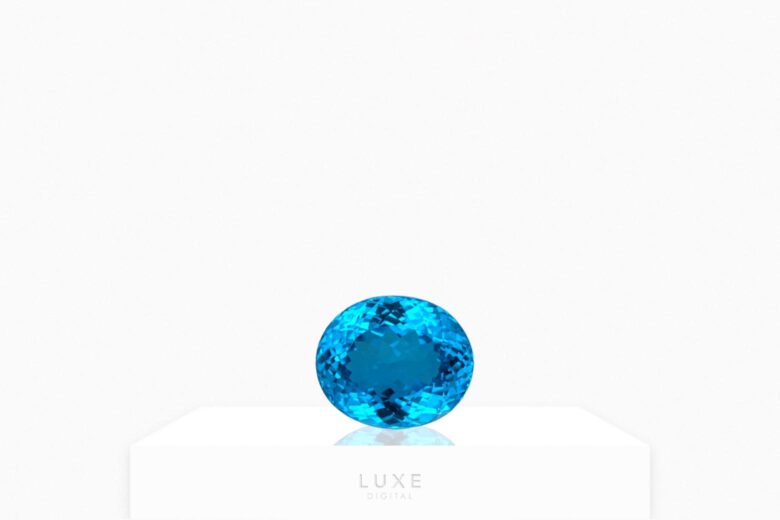
Topaz may be known for its yellow hue, but it’s also known for its intense blue. This show stopping gemstone has saturated hues and the range of blue colors is alluring. Icy blue, deep blue and cobalt blue are just a few examples. Its pleochroic colors, transparency and gorgeous faceting make it a highly desirable gemstone. Topaz comes from parts of Asia, Australia, North America, and Brazil.
Benefits and Use
While topaz gems are used for fine jewelry and collecting, topaz crystals are used for healing. Topaz protects you from harm and improves resilience.
Mohs Hardness Score: 8; suitable for fine jewelry, collecting. Price: $ to $$$
Turquoise
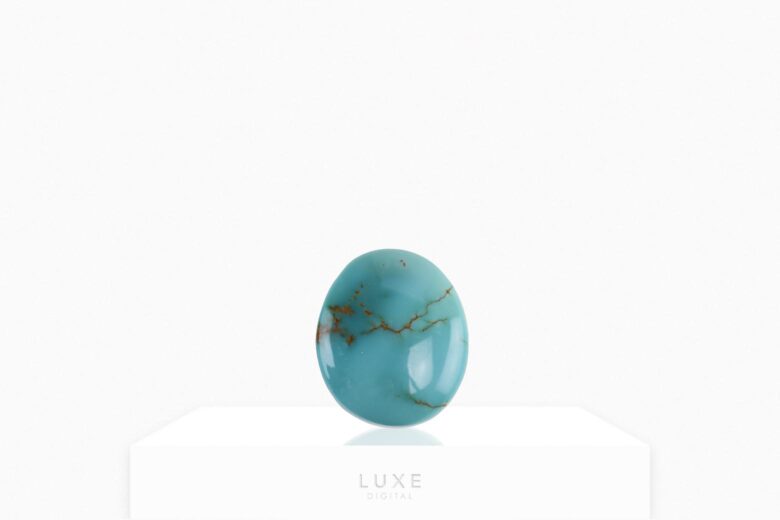
Turquoise is the only gemstone with a color named after it. This beloved blue gem features a breathless ocean blue body, accented with dark, rigid inclusions. It’s a form of phosphate that often has to be reconstituted to be made into jewelry. Turquoise is mined in multiple locations in the United States, but must be handled with care due to its chalky nature.
Benefits and Use
Turquoise is very popular for mass market and commercial beaded jewelry. It’s also used to cleanse negative thoughts and connect with a higher power.
Mohs Hardness Score: 5 to 6; suitable for costume jewelry but not everyday wear. Price: $
Viviante
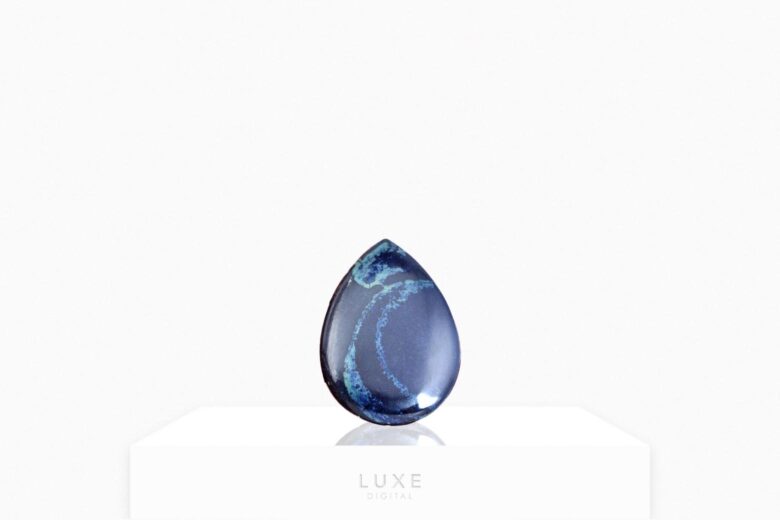
Viviante is a hydrated form of iron phosphate. While its crystals are initially colorless, deposits of iron and manganese provide a dark blue to blue green hue. Its crystals are elongated, flat, and deeply saturated. It’s a rare blue crystal found in the United Kingdom.
Benefits and Use
Viviante eliminates negative energy and clears the mind. It’s used for healing, meditation and collecting.
Mohs Hardness Score: 1.5 to 2; suitable for collecting. Price: $$ to $$$
Frequently asked questions about blue gemstones
Beauty is in the eye of the beholder, but a blue diamond is one of the most stunning blue gemstones. Other gorgeous blue gemstones include blue sapphires, aquamarine, and tanzanite. See our comprehensive list of the best blue gemstones for more inspiration.
Nearly 40 well-known gemstones are blue. Some examples include: blue moonstone, sapphires, lapis lazuli, turquoise and topaz.
Blue spinel is the rarest blue gemstone in the world. Blue spinel mostly comes from Sri Lanka and is formed with a unique mixture of iron and cobalt. While blue spinel is quite rare, other forms of spinel are far more common.
